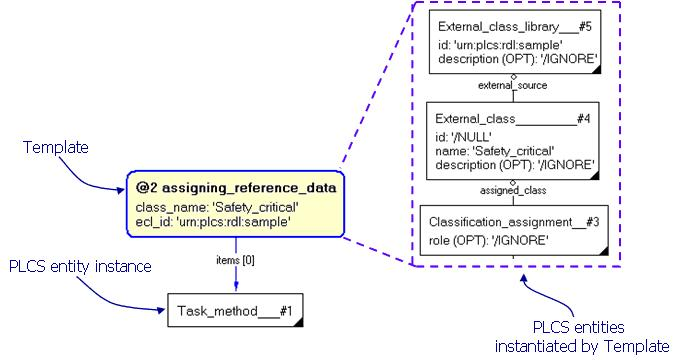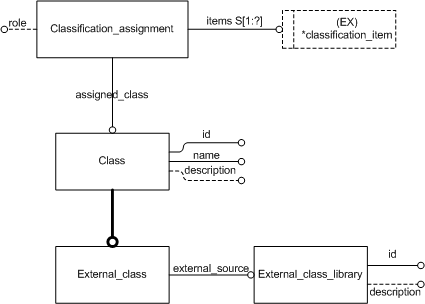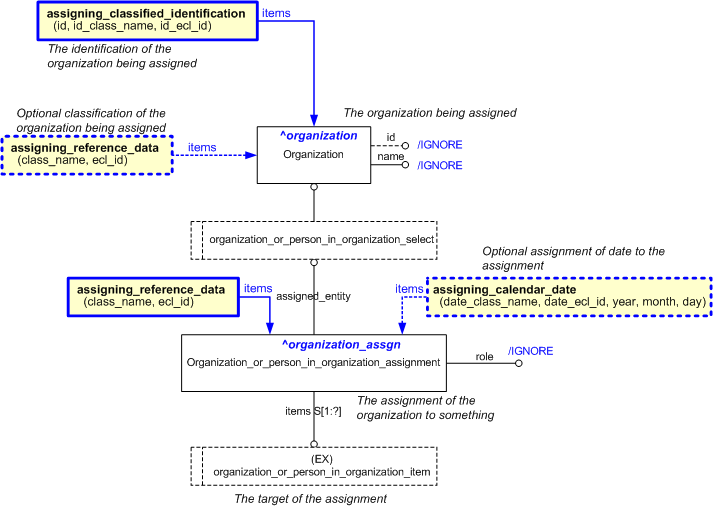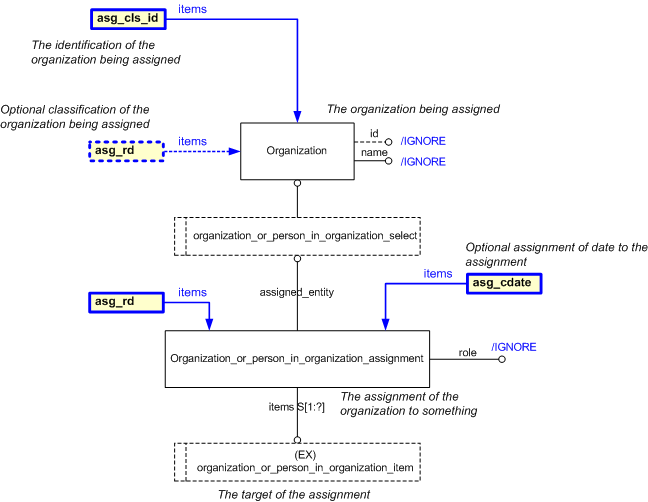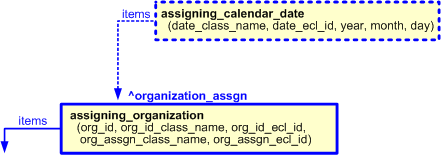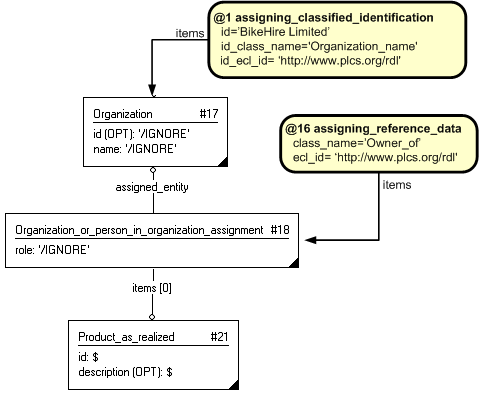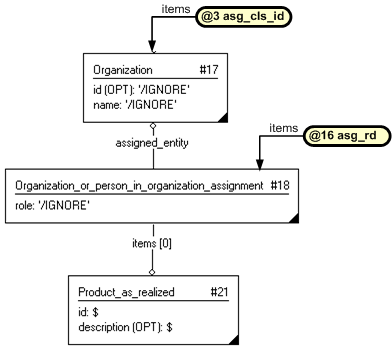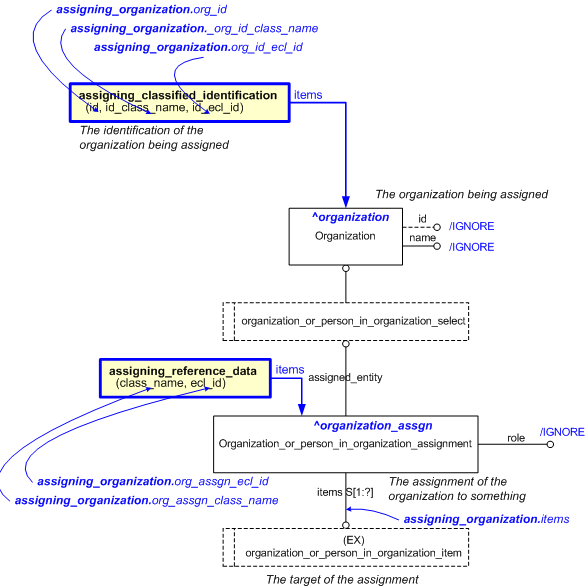| Help TOC > PLCS technical description > Templates
|
| Templates |
Date: 2010/02/10 16:32:29
Revision: 1.23
|
A Capability provides usage guidance on how the
ISO 10303-239
provides usage guidance on how the
ISO 10303-239 PLCS
PLCS information model should be used to represent a particular set of concepts,
such as parts or properties. The Templates have been defined to provide more precision to this
usage guidance. They specify the exact instantiation of a collection of
entities and attribute values, and external Reference Data
information model should be used to represent a particular set of concepts,
such as parts or properties. The Templates have been defined to provide more precision to this
usage guidance. They specify the exact instantiation of a collection of
entities and attribute values, and external Reference Data required to represent a particular
concept described within a Capability. It is an unambiguous specification of how to use a collection of
ISO 10303-239 PLCS entities, attributes and reference
data for a certain purpose within the context defined by a capability, thus ensuring consistent interpretation of use.
required to represent a particular
concept described within a Capability. It is an unambiguous specification of how to use a collection of
ISO 10303-239 PLCS entities, attributes and reference
data for a certain purpose within the context defined by a capability, thus ensuring consistent interpretation of use.
Each Capability may define more than one Template, each covering a different aspect of that Capability.
An example of this is the Capability C032: representing_activity (NB Capabilities are not documented in this release of the PLCS standard)
which
contains a number of templates such as:
assigning_activity,
representing_typical_activity and
representing_planned_activity.
See section
Capability for details on capabilities.
Definition:
A Template is a precise specification of which entities (and attributes) in ISO 10303-239 PLCS
should be instantiated, and which Reference Data should be used, to
represent a concept providing documented functionality in a Capability
should be used, to
represent a concept providing documented functionality in a Capability .
A Template defined and managed by the OASIS PLCS TC may be referred to as a "PLCS Template", as opposed to a "Business
Template"
.
A Template defined and managed by the OASIS PLCS TC may be referred to as a "PLCS Template", as opposed to a "Business
Template"
It is a "template for instantiation", which can be applied once, or several times -
in a sense a partial instantiation of ISO 10303-239 PLCS; partial in that it makes explicit the
instantiation of entities and specific attributes, but not all.
An example of a template is given in Figure 1.
Figure 1 —
The Template "assigning_reference_data", to the left,
is used to classify a Task_method as "Safety_critical".
The Template icon represents the instantiation of the three entity instances in the blue box to the right
A Template is explicitly defined to realize functionality expressed within a Capability (or Business Context ).
The Capability documents the concepts and information necessary to understand their differences,
dependencies and how each may be characterized for typical usage circumstances. The Templates define such
usage as an explicit instantiation (or arrangement) of PLCS entities providing the typical usage context through
external Reference Data. Templates are designed to be used (and extended - where relevant) by other Templates
which may reside in other Capabilities; hence a Template may be used across others,
e.g. the Template assigning_reference_data
is used in most other Templates (assigning classification data
is a fundamental part of ISO 10303-239 PLCS in OASIS). Here are some examples of Templates in
OASIS PLCS:
).
The Capability documents the concepts and information necessary to understand their differences,
dependencies and how each may be characterized for typical usage circumstances. The Templates define such
usage as an explicit instantiation (or arrangement) of PLCS entities providing the typical usage context through
external Reference Data. Templates are designed to be used (and extended - where relevant) by other Templates
which may reside in other Capabilities; hence a Template may be used across others,
e.g. the Template assigning_reference_data
is used in most other Templates (assigning classification data
is a fundamental part of ISO 10303-239 PLCS in OASIS). Here are some examples of Templates in
OASIS PLCS:
A Template represents a named abstraction of a grouping of ISO 10303-239
entities that are to be instantiated in order to represent the
concept. A Template is analogous to a procedure in procedural
programming languages.
The Template will define:
- What entities to instantiate;
- What attribute values to set on the entities;
- What Reference Data to be assigned (Both mandatory and
optional classification).
This will be represented both graphically by a model diagram showing the exact entities and attribute values
instantiated, and textually via a formal specification of the instantiation (through the instantiation path, a
syntactical definition of the exact steps of instantiation).
Each DEX will specify the set of templates that required to represent the information
represented by the DEX.
The EXPRESS schema of a DEX is then built from the referenced Templates' instantiation paths,
complemented by any additional entities the DEX has used directly.
schema of a DEX is then built from the referenced Templates' instantiation paths,
complemented by any additional entities the DEX has used directly.
Most templates belong to one of three basic types:
-
Representing - A full data set describing how to represent something. For example, the
template
representing_part specifies the
minimal set of information required to represent a part.
-
Referencing - Enabling the referencing of a target without the need to
send the complete representation. This would always include an
identification function. For example, the template
referencing_part
specifies the minimal set of information required to make a reference to a part.
-
Assigning - The ability to attach routine pieces of additional information,
as required, to elements within a representation.
For example, the template
assigning_identification
specifies how to assign an identifier to a target entity such as a Part.
For each Template, there is a status shown on the front page of the Template in DEXlib ,
The status can be either of:
,
The status can be either of:
- identified - recognized the need for a Template, should have a title and introduction
- planned - a modeller has been assigned with timescale
- in_work - modeller working on it
- end_modelling - modeller completed model, now ready for review
- in_model_review - modeller notified model reviewer to start review
- end_model_review - review by modeller finished
- model_review_issues_addressed - modeller finished addressing issues raised by modeller review
- in_business_review - modeller notifed business users to start review
- end_business_review - review by business users finished
- business_review_issues_addressed - modeller finished addressing issues raised by business user review
- complete - accepted by the dex coordination committee
- deprecated - use of the Template is deprecated
The statuses described are further explained on the pages describing the "Template development process".
An example of how a Template works can be made by looking at the Capability
"assigning_reference_data", which represents the assignment of a class to something.
The EXPRESS-G model diagram showing the entities that are to be
instantiated are shown in Figure 2.
A pattern like this is used throughout ISO 10303-239 to assign Reference Data.
Therefor a number of EXPRESS-G and instance diagrams will have to repeat this
pattern again and again, which will lead to complex and cluttered diagrams.
Consequently a Template can be created that provides an abbreviation for this pattern.
This is what is called a Template.
model diagram showing the entities that are to be
instantiated are shown in Figure 2.
A pattern like this is used throughout ISO 10303-239 to assign Reference Data.
Therefor a number of EXPRESS-G and instance diagrams will have to repeat this
pattern again and again, which will lead to complex and cluttered diagrams.
Consequently a Template can be created that provides an abbreviation for this pattern.
This is what is called a Template.
Figure 2 — Entities to be instantiated by assigning_reference_data Template
As well as specifying the group of entities to be instantiated, the
Template can also specify values for the entity attributes. These
values may be mandatory, in other words the attribute always has a
given value, or may be specified when the Template is used. For
example, the External_class_library
description attribute shall
always be set to '/IGNORE' wherever it is used. The Class
name
attribute however may be specified when the Template is used. For
example, when identifying a part number Reference Data is
assigned to an
Identification_assignment
entity and the Class
name
attribute is set of 'Part_identification_code'. The values are set
on the attributes by defining parameters on the Template, which are
set when the Template is used. This is analogous to arguments in
procedures in procedural programming languages.
There may be situations in which it is necessary to assign an entity
to an entity defined in the Template. For example, the Template
"assigning_identification"
specifies that the entity
Identification_assignment should be instantiated to assign the
identifier. There are cases when a date should be assigned to the
Identification_assignment entity. For example to represent when
the identifier was assigned. A Template can therefore have a
reference parameter which is used to mark a particular entity in a
Template as being referenceable from outside the Template. This is
analogous to a global variable in procedural programming languages.
A Template can be used in an information model (EXPRESS-G diagram)
to show a named abstraction of EXPRESS entities to be instantiated,
(See Figure 3 and Figure 4 for an example)
and
can be used in an instance diagram to show an example of a Template
being used (See Figure 6 for an example).
The graphical representation of a Template used in a DEX information
model includes:
- A blue rectangle shaded yellow indicating a Template;
- The name of the Template is in bold text in the rectangle;
-
If the rectangle has dashed lines then the use of the Template
is optional - otherwise the Template is mandatory;
-
The parameters of the Template are included in the rectangle. If
the parameter is to be set to a particular value, then it shall be assigned
in the parameter call, e.g. date_class_name='Start_date';
-
If any entity in the Template is an assigning entity, i.e. it has an
attribute whose type is another entity, the assignment is
represented by an arrow from the Template rectangle.
(For example the blue arrows with "items" text in Figure 5 below).
-
Templates or entities can be assigned to an entity "in" the
Template. This is represented by an arrow pointing at the
Template. In order to identify which entity in the Template is
being referenced, a reference parameter would have been set up
and is listed next to the arrow head, prefixed by ^.
An example is provided below in Figure 5.
As the graphic for the Template may be large, a miniaturised
symbol can be used for the Template. This comprises:
- A blue rectangle shaded yellow indicating a Template;
- A short name for the Template in bold text in the rectangle;
-
If the rectangle has dashed lines then the use of the Template
is optional;
An example of the graphical form for Templates for use in a model
diagram is shown in Figure 3.
The diagram shows an EXPRESS-G diagram representing the entities to be
instantiated to assign an organization. The diagram shows a
number of Templates that are assigning entities. For example, the
mandatory Template "assigning_reference_data" is assigning to the
entity "Organization_or_person_in_organization_assignment". The
optional Template "assigning_calendar_date" is assigning a date to
the same entity.
The diagram also shows the Organization and
Organization_or_person_in_organization_assignment entities being
being marked as reference parameters (^organization and
^organization_assgn respectively) that can be referenced from
outside the Template. An example of the reference parameters
being assigned to is given below in Figure 5.
Figure 3 — Graphical representation of assigning_organization Template
The same example using miniaturised Templates is shown in
Figure 4.
Figure 4 — Graphical representation of assigning_organization Template
An example showing the assignment of an entity to an entity "in" the
Template is given in Figure 5 below. The Template
"assigning_calendar_date" is being assigned to the
reference parameter ^organization_assgn on the
"assigning_organization" Template.
The reference parameter ^organization_assgn is bound to the
Organization_or_person_in_organization_assignment
entity in the
"assigning_organization" Template.
Figure 5 — Graphical representation of assigning a Template to an
entity in a Template
Instance diagrams show example instantiations of the model,
i.e. instances of entities. The diagrams have been extended to include a
graphic representing the Template showing the instantiation of the
Template. It includes:
-
A rounded rectangle indicating an instantiated Template;
-
An identification of the instantiated Template in the diagram,
prefixed by @;
-
The name of the Template being instantiated;
-
The values passed as parameters to the Template;
-
An assignment of the Template to other instances (the arrow).
As the graphic for the instantiated Template may be large, a miniaturised
symbol can be used for the Template. This comprises:
-
A rounded rectangle indicating an instantiated Template;
-
The object identifier (OID) of the instantiated Template,
prefixed by @;
-
The short name of the Template being instantiated;
Where miniaturised Templates are used, there may be a table
below the instance diagram showing the values of the parameters used.
An example of the graphical form for Templates for use in an instance
diagram is shown in Figure 6.
The figure shows an instance diagram showing the entities
instantiated to represent an organization owning a bicycle.
The 'BikeHire Limited' organization is assigned to a bicycle
(represented as a Product_as_realized) in the role of "Owner_of".
The diagram shows two instantiated Templates.
@1 assigning_classified_identification and @16 assigning_reference_data.
Figure 6 — Graphical representation of instantiated Templates
The same example using miniaturised instantiated Templates is shown in Figure 7.
Figure 7 — Graphical representation of miniaturised instantiated Templates
The following templates are instantiated in the diagram:
| Template |
Parameters |
|
@3 |
asg_cls_id |
items=
#17
|
org_id=
BikeHire Limited
|
org_class_name=
Organization_name
|
org_ecl_id=
http://www.plcs.org/rdl
|
|
@16 |
asg_rd |
items=
#18
|
class_name=
Owner_of
|
ecl_id=
http://www.plcs.org/rdl
|
|
Templates are defined within a capability. This section describes
the various section in the Template definition.
Each Template has a name, a description, a set of restrictions, a
set of input and reference parameters and an instantiation path, where the
instantiation path defines the EXPRESS entities that are to be
instantiated. The Template also includes Model diagrams and Instance
diagrams.
The name provides an identifier for the Template that is
unique to DEXlib.
The description of the Template is a free text description of
the purpose of the Templates.
The Template restrictions describe any constraints on the usage
of the Template. E.g. State when the Template should not be used.
Each Template will define a set of input parameters. These
allow values to be passed to the Template when used in an instantiation
path. The values can then be set to attributes in entities specified in the
instantiation path.
Input parameters are passed into the Template and their use in
the path is indicated by @<param name>.
Each parameter may be marked as optional, indicating whether a
value must be provided for the parameter.
A default value may be provided for the parameter.
The type of the parameter value may be specified as follows:
- STRING, NUMBER, INTEGER, REAL,
-
BOOLEAN (which has values TRUE FALSE)
-
LOGICAL (which has values TRUE UNKNOWN FALSE)
-
CLASS indicating that the type must a class defined in Reference Data.
The possible classification are defined by classification element.
-
URN, URL (Strings that are URNs or URLs)
-
ENTITY (an ENTITY - the actual entity is defined by the attribute entity_type)
-
SELECT (a SELECT - the actual select is defined by the attribute select_type)
NOTE
Where the type is a class, then a possible set of classes can
be identified. These may the super classes i.e. the class and its sub
classes are valid values, or an individual class, in which case just the
individual class is valid.
EXPRESS entities specified in the instantiation path can be bound
to reference parameters. The reference parameter can then be used elsewhere
in the instantiation path, in effect providing local variables.
The binding of an entity in a instantiation path to a reference
parameter is done by enclosing the reference parameter, marked by ^ and the
entity in %%. For example the entity External_class, can be bound to the
reference parameter ^ext_class as follows:
%^ext_class = External_class%
The External_class can then be used elsewhere in the path by
the use of ^ext_class.
If these entities are to be referenced when the Template is
used in the instantiation path of another Template, then they are declared in
the Template heading as reference parameters.
There are some circumstances where a combination of attribute values can be used to
uniquely identify an instance of an EXPRESS entity in a given data set. These
circumstances are normatively declared by a uniqueness constraint.
There two ways in which the constraint can be defined. An entity can be identified by stating the fixed
values of a set of attributes, or an entity can be identified by the values of the
Template input parameters.
An example of a constraint based on the fixed values of a set of attributes is where
is a requirement that any data set only contains one instance of the
entity
Product_category
with the attribute name="Part".
This would be defined by the following unique constraint:
Unique constraint: Unique product_category
There shall be at most one instance of the entity
(Product_category)
with the attribute
(name="Part")
instantiated in the data set.
An example of a constraint based on the parameter values of a Template is where a
Template instantiates a
View_definition_context.
This shown in in Figure 8.
Figure 8 — Entity instantiated by a Template
The Life cycle stage and application domain of the
View_definition_context
are then provided by assigning Reference Data. The values for the Reference Data are
provided by the Template parameters: domain, domain_ecl_id, life_cycle_stage, life_cycle_stage_ecl_id.
In any given dataset, there should only be one instance of a
View_definition_context
that has been classified with those parameter values. This would be defined by the following unique constraint:
Unique constraint: Unique view_definition_context
There shall be at most one instance of the entity (View_definition_context)
within the data set uniquely identified by a combination of the following Template parameters:
domain, domain_ecl_id, life_cycle_stage, life_cycle_stage_ecl_id.
The instance is referenced by the following Template parameter: contxt.
The instantiation path defines the set of entities that are to be
instantiated by the Template. It specifies:
-
entities to be instantiated;
-
the binding of an instantiated entity to a parameter;
-
values assigned to attributes on an entity where the values are
default values or values passed to the Template via Template parameters;
-
the instantiation of any entity assigned an entity already
instantiated;
-
the invocation of Templates to instantiate the entities defined by that
Template;
NOTE
The signature
for invocation is the name of the Template, plus the parameters. When using
the Template in a instantiation path, the signature is enclosed
in //. E.g.
/assigning_reference_data (items=^this, class_name=@date_class_name, ecl_id=@date_ecl_id)/
-
Single line comments;
NOTE
comments are on one line and prefixed by --, where
the comment is terminated by the end of that line.
The instantiation path is derived from the ISO 10303 SC4 reference path
syntax (SC4 Document: QCN241) so must follow an EXPRESS instantiation.
SC4 reference path
syntax (SC4 Document: QCN241) so must follow an EXPRESS instantiation.
The instantiation path may invoke other Templates.
The following notational conventions apply for the definition of instantiation paths:
|
||
|
enclosed section constrains the supertype entity;
|
|
->
|
the attribute, whose name precedes the -> symbol,
references the entity or select type whose name follows the -> symbol;
|
|
<-
|
the entity or select type, whose name precedes the <-
symbol, is referenced by the entity attribute whose name follows the <-
symbol;
|
|
[i]
|
the attribute, whose name precedes the [i] symbol, is an
aggregate; any element of that aggregate is referred to;
|
|
[n]
|
the attribute, whose name precedes the [n] symbol, is an
ordered aggregate; member n of that aggregate is referred to;
|
|
=>
|
the entity, whose name precedes the => symbol, is a supertype of the entity whose name follows the => symbol;
|
|
<=
|
the entity, whose name precedes the <= symbol, is a subtype of the entity whose name follows the <= symbol;
|
|
=
|
the string, select, or enumeration type is constrained to a
choice or value;
|
|
\
|
the instantiation path expression continues on the next line;
|
|
--
|
the text following is a comment;
|
|
//
|
Enclosed section invokes a Template. The word following the
/ is the name of the Template. The parameters to the Template are name
value pairs defined in () . E.g.
/assigning_reference_data (items=^this,
class_name=@date_class_name, ecl_id=@date_ecl_id)/
|
|
@
|
The text following the @ is the name of a parameter that has been passed into the Template. E.g.
External_class.name = @class_name
|
|
%%
|
Enclosed section specifies that the entity is bound to a parameter,
indicated by ^, that can be referenced from outside the Template. E.g.
%^ext_class = External_class%
|
|
^
|
The text following the ^ is the name of a reference
parameter that can be referenced from outside the Template.
|
|
$
|
The text following the $ identifies a reference parameter
in the preceding Template call. The syntax is
$<template_name>.<reference_parameter>, where
<template_name> is the name of the Template and
<reference_parameter> is the name of a reference parameter for that Template. E.g.
/assigning_organization(items=^part, org_assgn_class_name='Owner_of', org_id_class_name='CAGE')/
%^org_assgn = $assigning_organization.organization_assgn%
The Template assigning_organization has a reference
parameter ^organization_assgn. This is identified by
$assigning_organization.organization_assgn
and has been bound to the local reference parameter
^org_assgn.
|
Table 1 — Instantiation path syntax
Figure 6 shows a Template assigning_organization.
The Template has 5 input parameters:
-
org_id
The name or identifier of the organization.
-
org_id_class_name
The name of the class being used to classify the
identification
(Identification_assignment)
of the organization. This provides the role or reason for the identification. For example CAGE code.
-
org_id_ecl_id
The identifier of the
External_class_library
storing the definition of the class referenced by the parameter @org_id_class_name class.
-
org_assgn_class_name
The name of the class being used to classify the
assignment of the organization.
(Organization_or_person_in_organization_assignment)
This provides the role or reason for the assignment.
For example 'Owner_of'.
-
org_assgn_ecl_id
The identifier of the
External_class_library
storing the definition of the class referenced by the parameter @org_assgn_id_class_name.
-
items
The items to which the organization is assigned.
These are shown in the diagram in bold blue italic text. The
digram also shows how the parameters are used to set values on
the instantiated entities.
The Template has two reference parameters:
-
organization
which is bound the instantiated entity "Organization".
-
organization_assgn
which is bound the instantiated entity "Organization_or_person_in_organization_assignment".
The reference parameters are shown in the diagram in bold blue
text prefixed by a ^.
Figure 9 — Graphical representation of miniaturised instantiated Templates
The Template path for the assigning_organization Template shown
above in Figure 9, is as below. The comments (lines starting with --)
describes each line.
-- Instantiate an Organization
-- NOTE - an organization entity should only be instantiated once for
-- any organization
Organization
-- Bind the Organization to the parameter ^organization.
-- The parameter is a reference parameter so the Organization
-- entity can be referred to when this Template is used.
%^organization = Organization%
-- Set the Organization attributes id and name to be ignored
Organization.id = '/IGNORE'
Organization.name = '/IGNORE'
-- Identify the Organization
/assigning_classified_identification(items=^organization,
id=@org_id,
id_class_name=@org_id_class_name,
id_ecl_id=@org_id_ecl_id)/
-- Instantiate an Organization_or_person_in_organization_assignment
Organization_or_person_in_organization_assignment
-- Bind the Organization_or_person_in_organization_assignment
-- to the parameter ^organization_assgn
-- The parameter is a reference parameter so the
-- Organization_or_person_in_organization_assignment entity can be
-- referred to when this Template is used.
%^organization_assgn = Organization_or_person_in_organization_assignment%
-- Set the Organization_or_person_in_organization_assignment
-- role attribute to be ignored
Organization_or_person_in_organization_assignment.role = '/IGNORE'
-- Assign the organization to the
-- Organization_or_person_in_organization_assignment
Organization_or_person_in_organization_assignment.assigned_entity -> ^organization
-- classify the Organization_or_person_in_organization_assignment
/assigning_reference_data(items=^organization_assgn,
class_name=@org_assgn_class_name,
ecl_id=@org_assgn_ecl_id)/
-- Assign the Organization_or_person_in_organization_assignment.items
-- to the instances passed into the Template through the @items
-- input parameter
Organization_or_person_in_organization_assignment.items -> @items
 provides usage guidance on how the
ISO 10303-239
provides usage guidance on how the
ISO 10303-239 PLCS
PLCS information model should be used to represent a particular set of concepts,
such as parts or properties. The Templates have been defined to provide more precision to this
usage guidance. They specify the exact instantiation of a collection of
entities and attribute values, and external Reference Data
information model should be used to represent a particular set of concepts,
such as parts or properties. The Templates have been defined to provide more precision to this
usage guidance. They specify the exact instantiation of a collection of
entities and attribute values, and external Reference Data required to represent a particular
concept described within a Capability. It is an unambiguous specification of how to use a collection of
ISO 10303-239 PLCS entities, attributes and reference
data for a certain purpose within the context defined by a capability, thus ensuring consistent interpretation of use.
required to represent a particular
concept described within a Capability. It is an unambiguous specification of how to use a collection of
ISO 10303-239 PLCS entities, attributes and reference
data for a certain purpose within the context defined by a capability, thus ensuring consistent interpretation of use.
